As migratory creatures, hummingbirds relocate throughout the United States, based roughly on seasons. Many of these shiny birds winter in warm climates like Mexico or Guatemala, while others perch their tiny nests in New Mexico shrubs. Hummingbird migration runs as far north as Canada, with some buzzing their way all the way to South America for the winter.
Some hummingbirds, however, don’t migrate at all. Those living in California and the upper Pacific Coast, for example, generally stick around for most of the year, occasionally wandering eastward. Let’s take a look at the timing, reasons, and habits associated with hummingbird migration in the United States.
Hummingbird Migration Patterns in the United States
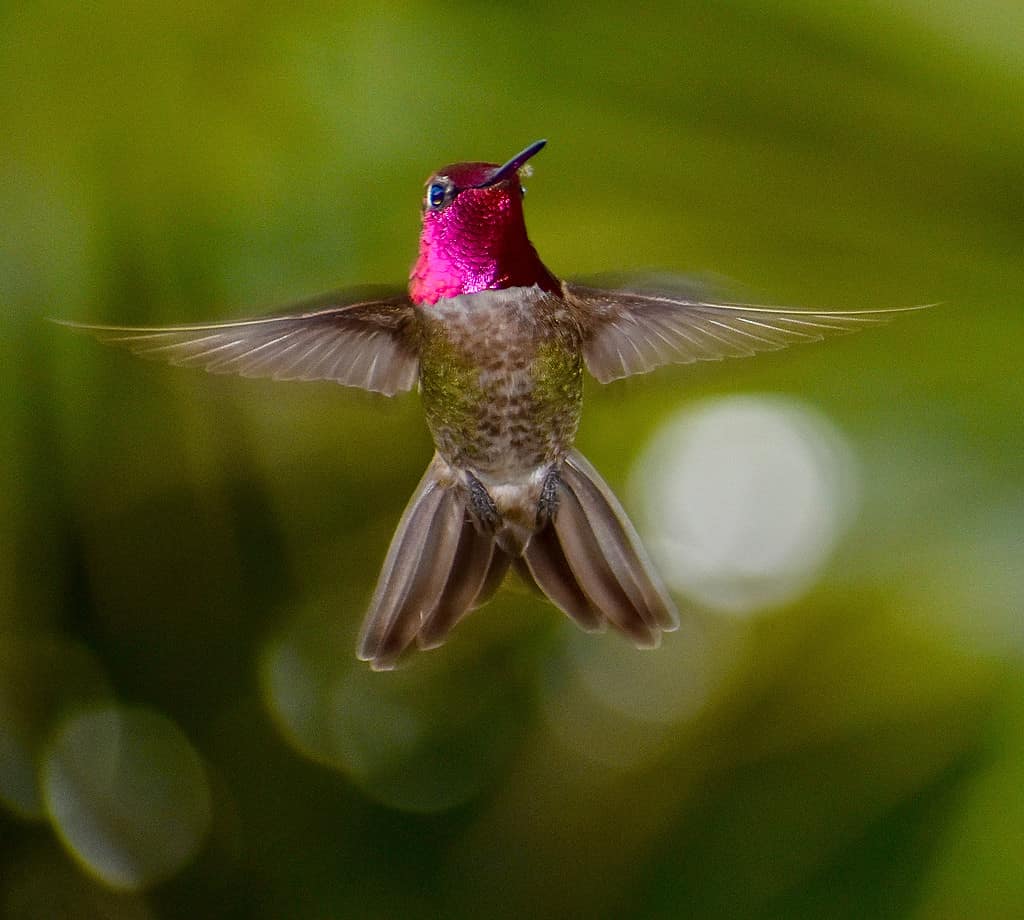
The exquisite Anna’s hummingbird with bright iridescent pink magenta is one of the hummingbirds you could see migrate this fall.
©Rachelle007/ via Getty Images
Generally speaking, hummingbird migration occurs in springtime or autumn. Different circumstances, however, impact the timing each year and general dates may vary.
Spring Hummingbird Migration
In springtime, when daylight extends and darkness shrinks, hummingbird migration begins. The warm weather draws these tiny birds northward to start their migration as early as February and usually no later than March, depending on their destination.
Male hummingbirds first begin their flight northward, often with folks spotting them in gardens and forests along the Gulf Coast. The weather, of course, dramatically impacts the timing, but generally first appearances in the southeast pop up in March. Folks as far west as Texas and as far east as Florida should begin seeing these buzzy fliers begin their garden runs.
Springtime migration frequently takes hummingbirds about a month to span half the distance of their flight. Folks in the Midwest likely will begin seeing hummers make their way through beginning in mid-April. Often, this occurs around Easter weekend when the flowers first begin to pop up.
May is likely the first appearance of hummers in the northern end of the country, as well as Canada. As flowers spread out their petals, hummingbirds begin appearing.
Autumn Hummingbird Migration

The Berylline hummingbird makes its way south as early as late July.
©Wang LiQiang/Shutterstock.com
As summer melts into autumn, hummingbirds sense the weather changes brewing and begin their departure to warmer climates. This usually occurs toward the end of August or September. Food sources will begin drying up around this time and air temperatures begin dropping. These little birds need plenty of natural food and warmth to survive, so their instincts kick in.
The heat of the summer, often at its height this time of year, means hummingbirds will eat and fly out early in the morning to prepare for the long, hot day ahead. Late afternoon calls for another fuel up, so the birds make their ways into gardens and backyards looking for more food to energize their journeys.
The southern coast of the United States generally sees the last migrating hummingbirds during September. The hummers have usually made their way down south by this time, avoiding the impending cold weather.
When and Where Does Hummingbird Migration Take Place?
While the migration season changes somewhat each year, generally speaking March 1 and September 1 may help. Keep these dates in mind for hummingbird migration and start setting out those feeders! If the weather is warm where you live, you’re more likely to spot these sparkling hummers buzzing about.
At these times, different species will be spread out around America. Those coming from South America won’t have arrived yet. But those in the southwest, Mexico, or Caribbean will likely begin seeking nectar in your neighborhood sometime soon.
Most commonly, ruby-throated hummingbird males in the eastern half of the United States will show up first. In the west, you’ll see black-chinned and Anna’s hummingbirds first. Rufous hummers stick around the Pacific Northwest but may drift eastward in some cases.
Migration Triggers for Hummingbirds

Things like food availability may trigger hummingbird migration from area to the next.
©yhelfman/Shutterstock.com
Several factors trigger hummingbird migration. The factors vary from species to species and from one area of the country to the next.
Natural Food Sources
As seasons change, natural food sources change for hummingbirds. During spring and summer, flowers, fruit, and other hummingbird foods appear in northern regions. These birds instinctively know, based on weather and other things, when to head out in search of it.
Weather Patterns
Weather patterns and seasonal changes also trigger migration for hummingbirds. Things like local storms and strong winds may impact them, while temperatures and fronts also impact when these birds move.
Age
Mature hummingbirds begin their migration sooner than younger adults. This occurs because older birds may require more time to make the journey. Birds that hatched earlier in the year may also fly north earlier than those born later in the year for the because they are ready sooner.
Bird Sex
Males typically migrate a few days to a week or more before the females of the species. This allows the males to establish their territories in the north before the females join them for breeding season. This may also happen as the birds fly south for the winter.
Total Migration Distance
The total distance a hummingbird must travel during migration will also impact the start date of their flight. Those that travel the farthest, like the rufous that flies from Mexico to Alaska, will begin its migration before other species traveling a shorter distance.
Hummingbird Migration Patterns by Common Species
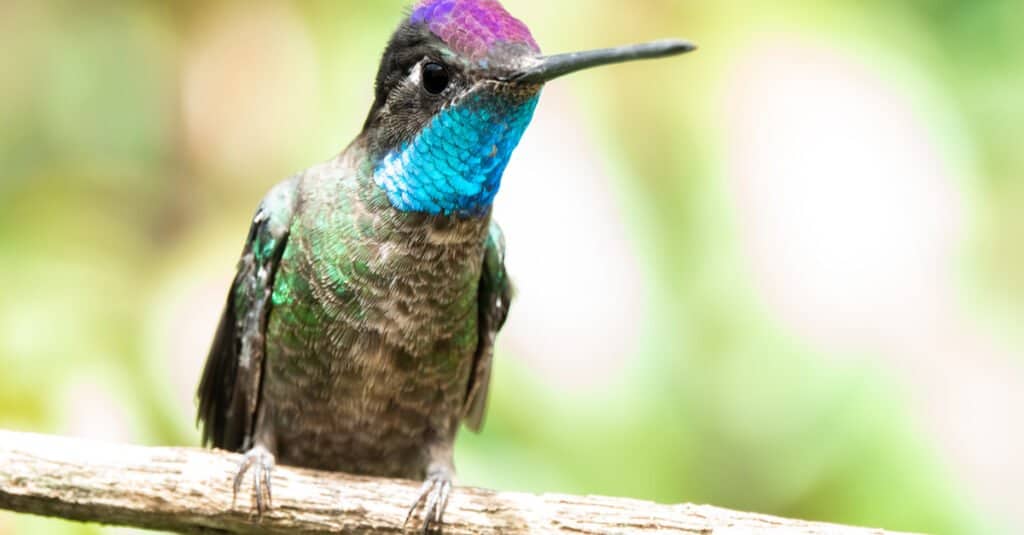
The Rivoli’s hummingbird is one of the most colorful species found in the United States. These stunners fly north in early spring to the mountains to find mates.
©Jeroen Mikkers/Shutterstock.com
Over 350 species of hummingbirds exist in the world. Fifteen of these make their way through the United States, with nine migrant species. Several of these hummingbirds migrate, but a few remain primarily in the same areas all of their lives. Hummingbirds don’t migrate as a flock, though, so you’ll never see a humming V zipping through the air. Instead, each bird migrates solo.
You may spot any of the following hummingbird species, depending on where in the United States you live.
- Rivoli’s hummingbird
- Blue-throated mountain gem hummingbird
- Lucifer hummingbird
- Broad-tailed hummingbird
- Black-chinned hummingbird
- Anna’s hummingbird
- Costa’s hummingbird
- Ruby-throated hummingbird
- Rufous hummingbird
- Allen’s hummingbird
- Berylline hummingbird
- Calliope hummingbird
- Broad-billed hummingbird
- Buff-bellied hummingbird
- White-eared hummingbird
- Violet-crowned hummingbird
- Mexican violetear
- Green-breasted mango hummingbird
- Amethyst-throated mountain gem hummingbird
- Plain-capped starthroat hummingbird
- Bahama woodstar hummingbird
- Xantus’s hummingbird
- Cinnamon hummingbird
- Bumblebee hummingbird
Ruby-throated Hummingbird
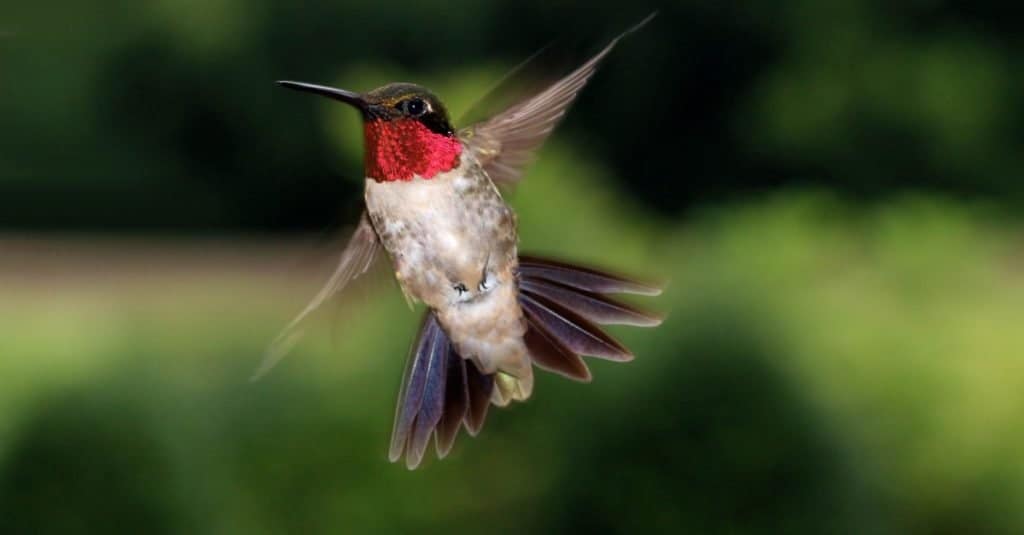
Ruby-Throated Hummingbirds typically migrate to spend winters from Mexico to Panama.
©Ramona Edwards/Shutterstock.com
Probably the most commonly spotted hummingbird, at least on the East Coast, the ruby-throated hummer is a migratory species. They surge northward in early spring and return southward again in late August or early September. Most of these birds winter in southern Mexico or Central America. When they’re in your area, they will likely frequent your backyard feeder as well as hang out along forest edges.
Rufous Hummingbird
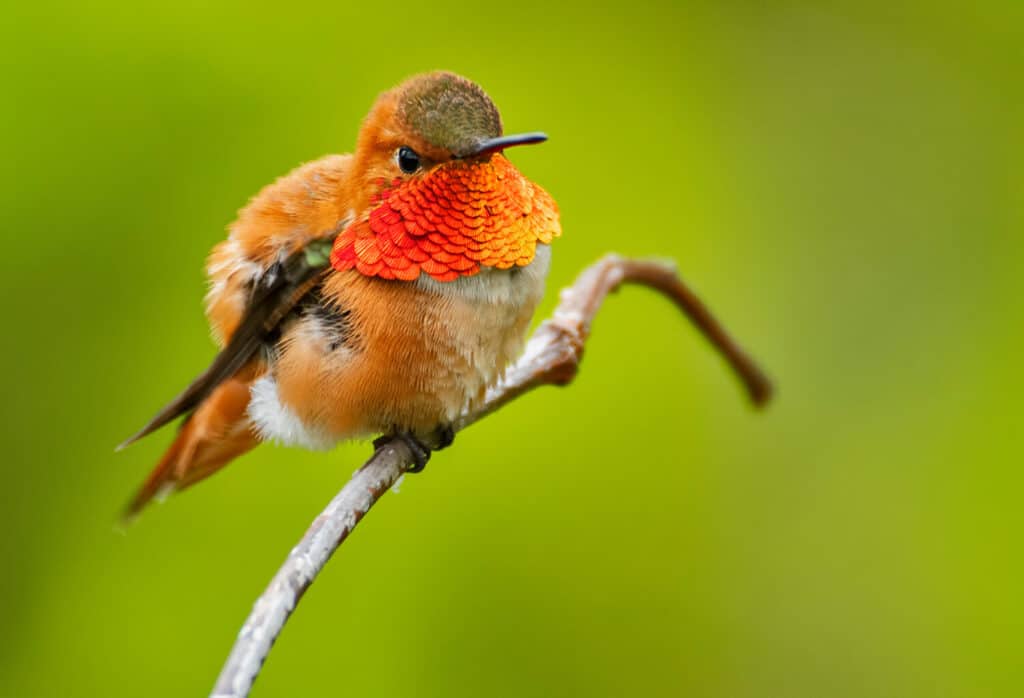
Rufous hummingbirds have the longest known hummingbird migratory distance. They travel nearly 4,000 miles every year!
©punkbirdr/Shutterstock.com
The rufous hummingbird makes one of the longest-known migratory journeys in the ornithological world. These birds winter in Mexico and fly northward in spring, journeying nearly 4,000 miles before landing in Canada and Alaska for their summertime season. They arrive here by May then head back south again in July.
Black-chinned Hummingbird

Black-chinned hummingbirds migrate in the summer and head back to Mexico in September.
©rck_953/Shutterstock.com
Spreading across much of the western half of the United States of America, black-chinned hummers enjoy a wide range of habitats. They make their flight northward for the summer months, leaving Mexico in spring, and then frequent feeders in urban, rural, and suburban areas. After breeding and feeding, they head into the mountains to feast on the glorious flowers here. Then, it’s back south again in the autumn, usually September.
Allen’s Hummingbird
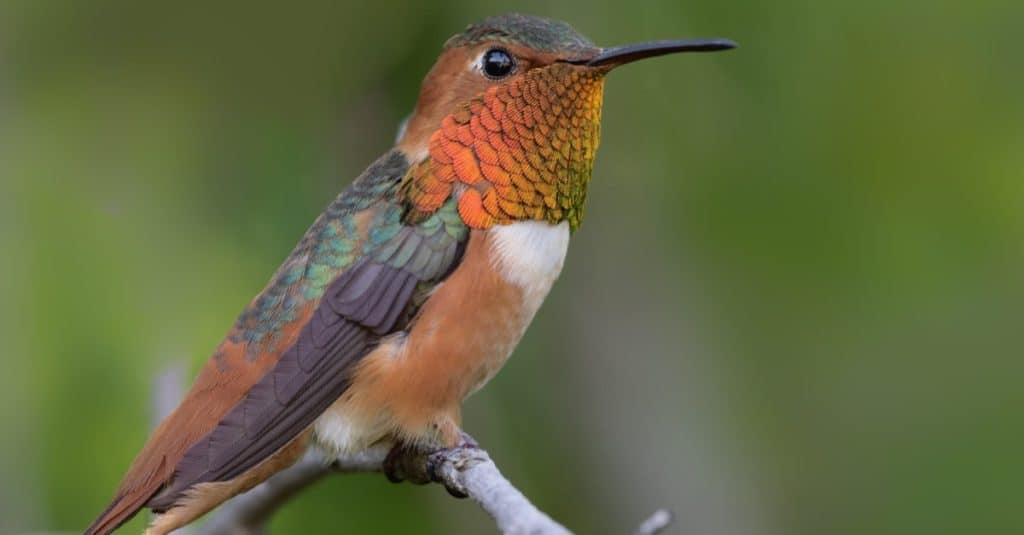
The Allen’s Hummingbird may migrate or stay put, depending on the year and the location.
©iStock.com/Angel Di Bilio
Allen’s hummingbirds are both migratory and residents in the United States. The unusual birds make their migratory trek to Mexico, California and Oregon in early December for wildflower season. After breeding, males venture off to coastal scrub terrain while the females move into forests for nesting. Many of the rest stay put in these same basic regions year-round, enjoying the warm climate and bountiful food.
Anna’s Hummingbird
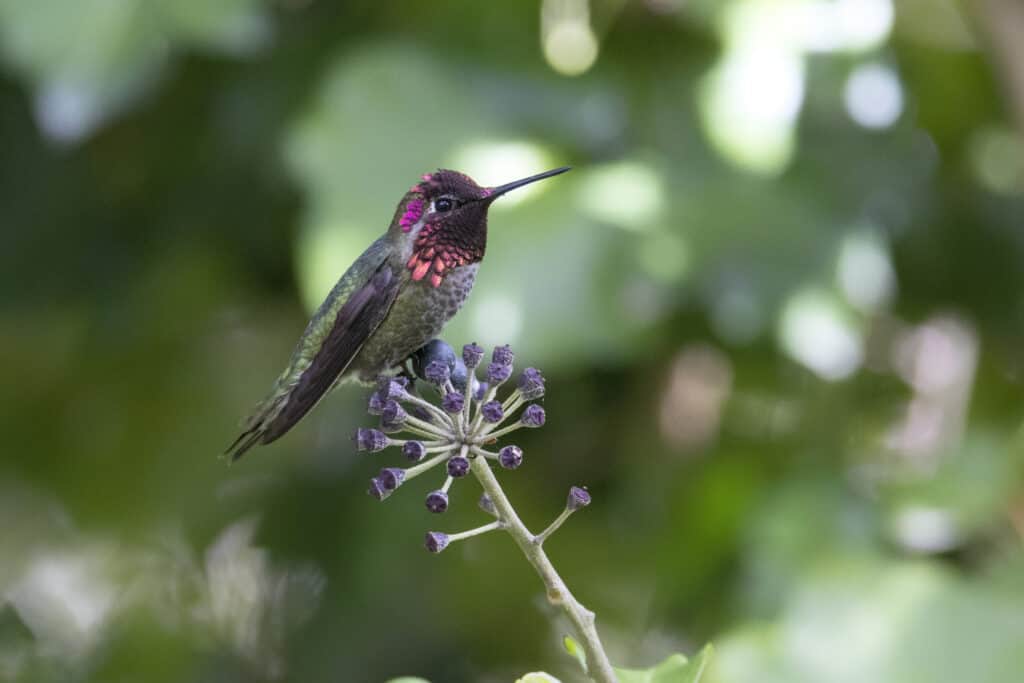
Like many species, the male Anna’s hummingbird is more brightly colored than the female. This makes them easier to spot when they migrate.
©Devonyu /Shutterstock.com
Unlike many other North American species, Anna’s hummingbirds do not migrate. Instead, these beauties stick around their basic home area, veering only short distances away for extra food. These birds inhabit northern Mexico to southern Canada ranges on the west coast. Originally, their breeding range was much smaller, confined to Baja and Southern California, but as the plants have migrated northward, so have the birds.
Broad-tailed Hummingbird
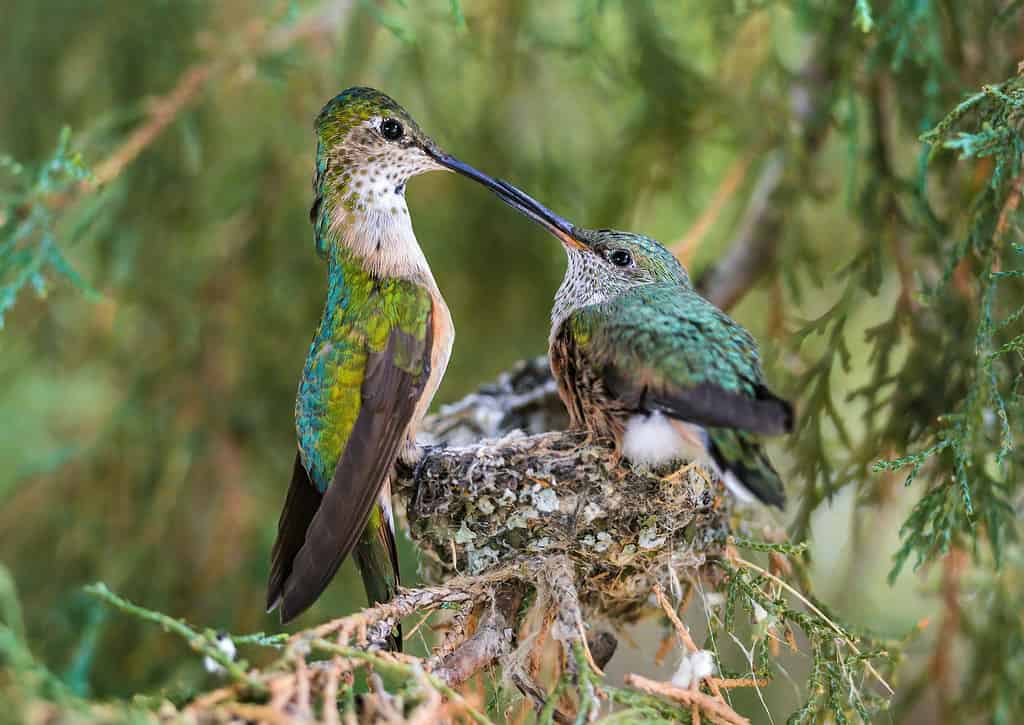
Females and immature Broad-bills hummingbirds have a dull green plumage on their back and wings, with a whitish-gray breast and belly. The males generally migrate first, as early as February.
©Susan Hodgson/Shutterstock.com
During springtime, broad-tailed hummers shift northward, away from central America and Mexico where they winter. Generally, males leave first, heading to Arizona and arriving by late February or early March. By early April, they’ve made their way into northern Arizona, and by late April, they’ve made it to Colorado. Afterward, they continue northward, reaching Wyoming by mid-May, and then settle into southern Montana or Idaho by late May for breeding season.
After their breeding season ends, broad-tailed hummingbirds return southward to Mexico all the way down to Guatemala.
Calliope Hummingbird

Calliope hummingbirds travel from Mexico all the way to Alaska in migration season.
©iStock.com/McBenjamen
These unique and stunningly colored birds travel from Mexico into Arizona and New Mexico as spring hits. They seek out mountain areas of the northwestern United States, into Canada and Alaska, for breeding grounds. They typically reach breeding grounds by late May. When breeding season is over, the birds return southward, heading to Guatemala, Belize, and Mexico for the winter months.
Costa’s Hummingbird
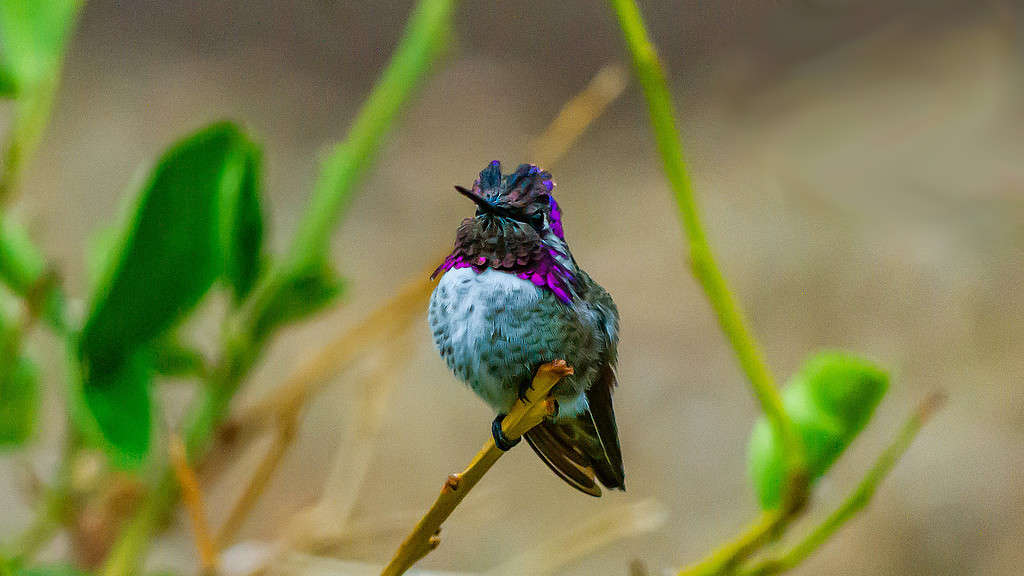
Costa’s Hummingbirds have vivid heads and stout little bodies. This helps them blend into their native home in the desert. They rarely roam far from home.
©Peter Milota, Jr./ via Getty Images
Primarily desert species, Costa’s hummingbirds inhabit the southwestern United States and Mexico for most of their lives. They do sometimes wander north or eastward and have been spotted elsewhere in the country, even thousands of miles away. They’ve also been spotted in Alaska and some regions of Canada.
They generally remain in the desert regions, though, moving from southern California and Mexico in springtime to the Mojave Desert, Sonoran Desert, and San Joaquin Valley of California for breeding season.
Hummingbird Conservation
While most American hummingbird species fit on the Least Concern list, the habitats and food sources for them are rapidly disappearing. This means that in the next few decades, we’ll see a further decline in the numbers and the birds could well wind up endangered or even extinct.
We can each do our part to help save these stunning birds from extinction, though! Following guidelines, such as ignoring hummingbird nests and eggs are just a start. We can also plant hummingbird gardens and put out dye-free hummingbird nectar. We can advocate for habitat protection and use bird-friendly measures in our homes and gardens.
We can also report our hummingbird sightings to help conservancy efforts track these tiny birds.
How to Report Your Hummingbird Migration Sightings
As you keep an eye out for hummingbirds in the garden, woods, and fields, several things could be jotted down to help track their migration and population.
- Pay attention to their appearance. Not only identify which species you’ve seen with an app like Merlin Bird ID, but see if you can tell if the bird is male or female. In most cases, males have more vivid coloration. This means males are the easiest to identify of their species, as well, since many females look similar.
- Log your sightings on the Hummingbird Migration App. This helps the experts track where they’re being seen.
- Check your feeders often. Enjoy the birds visiting them, certainly, but also note how quickly the nectar drains. The faster the draining, the more hummingbirds are present in the area. This likely means migrating hummers are in your area.
The photo featured at the top of this post is © Wang LiQiang/Shutterstock.com
Thank you for reading! Have some feedback for us? Contact the AZ Animals editorial team.






